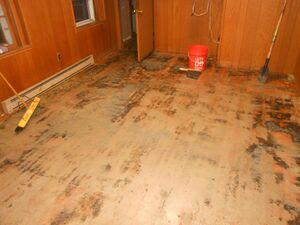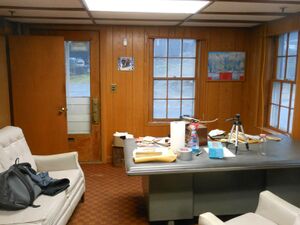Aliphatic Urethane for Hardwood Floor Refinishing
This was a project undertook by a member of Advance Coatings, co. starting in 2019. The overall project was for renovation of an office, which encompassed the following projects
- Renovate walls by returning to original Brick
- Remove carpeting, and restore original Hardwood Floor
- Open Ceiling, by removing drop ceiling tiles
- Rewire Electrical with accessible conduit
- Misc painting, drywall, trim, and wiring of low voltage.
Of interest to us here is the floor refinishing. This refinishing was done with the help of a Urethane we resell. This document will go into detail the full hardwood floor refinishing process in as much detail as possible (after the fact). This info will be useful to those interested in Refinishing, as well as those interested in general Urethane advice with hardwood. Note that this page is meant as an adjunct to the Aliphatic Urethane page. It is recommended to be familiar with that page as well.
Original Floor
The office was originally a hardwood floor, from a building built in the 1930-40's. At one point afterwards, a black tar glue was put on the floor, followed by plastic (vinyl, perhaps) tiles. In the 1960-70's, there was carpeting installed, over the original hardwood and tiles. The first step was removal of the carpeting, and tiles.
Removing Tar Glue from Hardwood with Hot Water
Removal of the carpeting was uneventful, outside of some dust. Removal of the tiles was also effortless, however the black tar below was seemingly glued to the hardwood. An associate in the construction business was consulted, and he recommended hot water and scraping to remove the black tar[1].

The trick to the black tar that we dealt with, was to use lots of water, and have the water be as hot as possible. It was also helpful to let the water sit on the tar for some time, in order to soak in. In the end, no concern was paid to overwatering the hardwood, and ample amounts of water, along with some hours of scraping, led to a floor 95\% clear of black tar. The black tar left a detergent or glue film to the wood, but this was not a problem. The sanding would soon remove this.
Sanding the Old Floor
- ↑ According to this person, hot water was the most effective at removing this tile glue. The other options advertised, solvents and what not, were not as effective.
